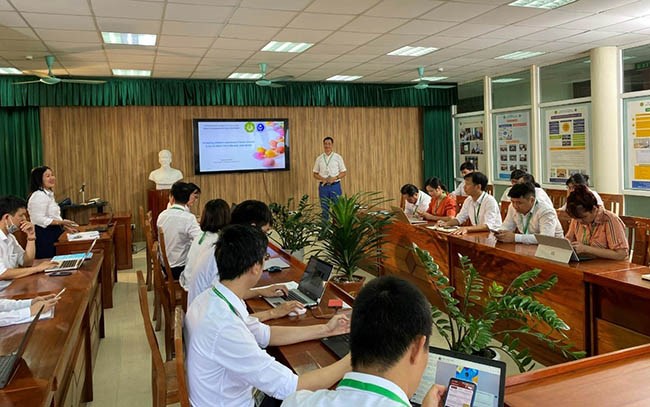Increasing children's awareness of Green Growth in Ho Chi Minh City in the 2021-2030 period
Updated on 09:35, Wednesday, 14/09/2022 (GMT+7)
Within the framework of regular professional activities of strong research groups, on September 12, 2022, Dr. Quyen Dinh Ha - a member of the Strong Research Group in Rural Development, Faculty of Economics and Rural Development, presented a seminar on the topic "Increasing children's awareness of Green Growth in Ho Chi Minh City in the 2021-2030 period".
Within the framework of regular professional activities of strong research groups, on September 12, 2022, Dr. Quyen Dinh Ha - a member of the Strong Research Group in Rural Development, Faculty of Economics and Rural Development, presented a seminar on the topic "Increasing children's awareness of Green Growth in Ho Chi Minh City in the 2021-2030 period". The topic is of special interest to lecturers and staff of the faculty when children are an important subject, directly and indirectly related to 11 SDGs (Goals) and 28 targets in the Program 2030 Agenda for Sustainable Development. Children are the most vulnerable group to climate change due to their physical and psychological vulnerabilities, the disruption of services essential to development, their high dependency on climate change, children's attitudes toward parents and careers, as well as limited rights to participation and representation, and a lack of intergenerational equity. Because children and young people are important groups of Vietnam's future and they are also agents of change now and in the future to be able to further develop resilience. They also have the capacity to deal with the shocks and stresses of climate change. Therefore, the Vietnamese Government has requested the assistance of development partners to effectively implement policies and actions to realize children's rights.
    |
 |
| Dr. Quyen Dinh Ha – presenter and participants of the seminar |
Climate change has become more serious on a global scale and Vietnam has been considered one of the most vulnerable countries suffering the impacts of climate change. Hence, it is necessary to include children at the core of developing green growth strategies to achieve a green city. This research engaged 494 children as respondents. The research results revealed that children's participation in green growth activities was not included in the green growth action plan of Ho Chi Minh City but they participated in programs to achieve a green city by planting trees in schools, implementing energy conservation at home, and collecting battery waste to strengthen green consumption behavior. Other activities in the city include improving green production activities in industrial production, reducing emissions, increasing the ability to absorb greenhouse gases, reducing energy consumption in electricity, coal, oil, and gas, and raising the rate of using renewable energy, urban climate change adaptation, and disaster prevention towards a low-carbon economy. Results also show that most of the children-respondents expect to access urban parks as safe places to play and have fun.
To build Ho Chi Minh City to become a green city, it is necessary to meet the needs of urban green space development, and establish an environment-friendly city in the city's socio-economic development plan, urban construction planning, and urban development up to 2030. It is also recommended to include the children in the Green Growth Plan in Ho Chi Minh City up to 2030, particularly in the socio-economic development strategies for ensuring children’s rights according to the 2016 Children Law and including climate change topics in schools and in extracurricular activities, strengthening communication on the green growth to children as the main audience, and to enhancing linkages among all sectors towards achieving sustainable development.
The Rural Development Research Group, VNUA